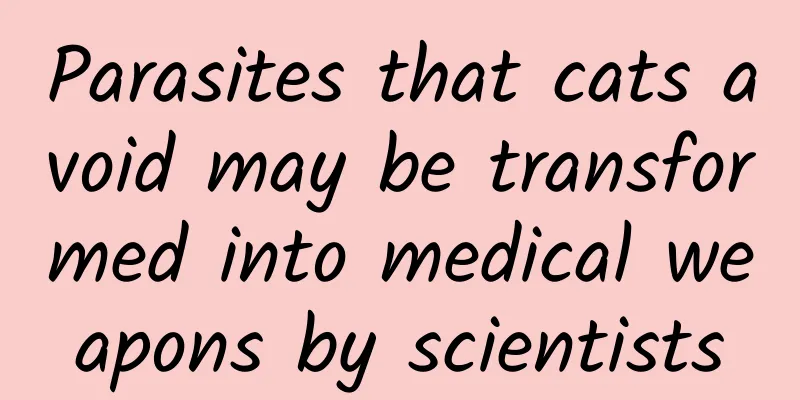Parasites that cats avoid may be transformed into medical weapons by scientists

|
When we talk about Toxoplasma, we tend to think of cats immediately because they are common parasites in cats. Pregnant women are highly vigilant about Toxoplasma because it may harm the health of the fetus. However, scientists have recently discovered that Toxoplasma may be used as a tool to treat some brain diseases. Why can parasites be used to treat diseases? Let's start with the characteristics of Toxoplasma gondii. What is Toxoplasma gondii? At first glance, the name Toxoplasma may make people think that it is a worm that looks like a bow and wriggles like a roundworm or earthworm. In fact, Toxoplasma is much smaller. It is a single-cell parasite, 3.5 to 6.5 μm long and 1.5 to 3.5 μm wide. Its shape is more like a banana than a bow. Figure 1 Micrograph of Toxoplasma gondii (Image from Wiki) Toxoplasma gondii is found in many animals, including cats, birds, pigs and humans. It is an opportunistic parasite, which means that in the absence of a healthy immune system, infection with Toxoplasma gondii usually does not cause clinical symptoms. The life cycle of Toxoplasma requires two hosts. The intermediate hosts include reptiles, fish, insects, birds, mammals and humans, while the definitive hosts are only cats. Copyright image, no permission to reprint Toxoplasma gondii can also infect humans, which may cause them to suffer from "acquired toxoplasmosis." Adults infected with Toxoplasma gondii have almost no symptoms, but children infected with Toxoplasma gondii sometimes suffer from symptoms such as visual impairment, pneumonia, and encephalitis, so prevention is still necessary. Once a pregnant woman is infected with toxoplasmosis, it will cause great harm , because toxoplasmosis infects the fetus and may cause "congenital toxoplasmosis", leaving the fetus with many serious sequelae, such as intellectual disability, visual impairment, epilepsy, mental development disorder, etc. Therefore, it is very necessary to check pregnant women for toxoplasmosis, and if infected, targeted treatment is required. One of the important reasons why Toxoplasma can harm the human body is that it can invade our central nervous system. However, it is precisely because of this characteristic that some scientists are currently trying to make Toxoplasma "reform" and put it to good use. How does Toxoplasma gondii serve humans? Proteins are important tools in biomedicine, and many drugs are proteins. However, proteins are biological macromolecules with large size, which can interact with the host immune system and have difficulty penetrating barriers (such as the blood-brain barrier). How to effectively deliver them to target cells has become a major problem that plagues the medical community. Toxoplasma gondii is naturally able to enter the central nervous system from the human intestines. Scientists have come up with a bold idea - can they deliver therapeutic protein drugs to the brain by modifying Toxoplasma gondii? Recently, Shahar Bracha and others published their research results in Nature Microbiology. They designed a new strategy to use two secretory organelles of Toxoplasma gondii - rhoptry bodies and dense granules - to deliver proteins to mouse brain cells. They selected proteins located within the parasite's organelles and fused them to different proteins known to treat human neurological diseases, and the results showed that these large proteins could be delivered to neurons via both organelles at the same time. Figure 3 Modification of the secretion system of Toxoplasma gondii for delivering large molecule therapeutic proteins to neurons (Image source: Reference 3) As proof of concept, the scientists tested MeCP2, a protein used to treat Rett syndrome, a rare neurological disorder that affects brain development, and found that it could be delivered to neurons in mice and bind to target DNA, altering host gene expression within cells, neurons and brain organoids. At the same time, few parasites were detected outside the target delivery site, and no obvious inflammation occurred after delivery. Scientists say these findings could provide a new method for therapeutic protein delivery, but further research is still needed to understand its effectiveness and safety. Figure 4 3D image showing Toxoplasma gondii (fluorescently labeled) entering mouse brain cells (Image source: Reference 3) How to prevent Toxoplasma gondii? Although cats can indeed transmit Toxoplasma to humans, this does not mean that we need to give up the pleasure of petting cats. Because cats are not born with Toxoplasma, they will only be infected when they come into contact with an intermediate host infected with Toxoplasma. Figure 2 Cat (Photo credit: taken by the author) When a cat is infected, Toxoplasma gondii mainly lives in the cat's intestinal cells and can also enter other organs through the bloodstream. After two to four weeks, the eggs can be excreted from the body in the cat's feces. Cats around it will also be infected if they come into contact with feces carrying Toxoplasma gondii. Therefore, the following precautions can be taken: ① Do not let cats drink untreated water directly, such as tap water; ② Avoid letting cats wander outside; ③ It is recommended to feed cats with ready-made cat food or fully cooked homemade food to prevent cats from eating raw or half-cooked meat directly; ④ Clean and replace cat litter in time. It should be noted that, generally speaking, the vast majority of cats infected with Toxoplasma gondii will not show obvious symptoms. A very small number of cats are less sensitive to Toxoplasma gondii and may have symptoms related to the central nervous system, vision, respiratory, gastrointestinal system, etc., such as fever, shortness of breath, cough, etc. If these symptoms occur, you can go to the pet hospital to comprehensively determine whether the cat is infected with Toxoplasma through "fecal egg detection" and "serum antibody detection". If you confirm that your cat is infected with Toxoplasma, you can try to give the cat antibiotics such as clindamycin or sulfonamides, or consult a professional pet doctor for targeted treatment. References [1] Wen Liangzhen et al. Effects of Toxoplasma infection in pregnant women on fetal growth and development. Chinese Journal of Obstetrics and Gynecology, 2003, 38(6): 331-333. [2] Wang Qinying et al. Infectious Diseases, China Medical Science and Technology Press, 2016. [3]Shahar Bracha et al. Engineering Toxoplasma gondii secretion systems for intracellular delivery of multiple large therapeutic proteins to neurons. Nature Microbiology, 2024, 9: 2051–2072. Planning and production Author: Denovo team Review丨Zhang Yu, researcher/PhD, Chinese Center for Disease Control and Prevention, national health science expert Planning丨Ding Zong Editor: Ding Zong Proofread by Xu Lailinlin The cover image and the images in this article are from the copyright library Reprinting may lead to copyright disputes |
>>: The tap water in residents' homes is yellow! How did the tap water change color?
Recommend
Did prehistoric civilization exist? If not, where did this 300 million-year-old screw come from?
The Earth is about 4.6 billion years old since it...
Bilibili Product Analysis | "Not just to become the 'Chinese YouTube'!"
Bilibili has developed over the past ten years, f...
Experts point out four major problems in home kitchens. Are you affected?
Data shows that the oil and salt intake of Chines...
Mosquito-repellent coil-shaped UFOs? No problem, we're old friends.
On the night of April 17 this year, the Hawaiian ...
Mushrooms can talk, too, and they can say 50 words! No, they're probably just smacking their lips!
Humans are not the only ones in the world who can...
Artificial intelligence is "entering" the legal profession, will it replace lawyers and judges?
On August 24, 2023, the Science Popularization Ch...
Taobao Live is not a panacea!
At the end of last year, I was still attending va...
Liu Li from Wuhan Central Hospital died of COVID-19. Another employee of Wuhan Central Hospital died of COVID-19!
On the morning of March 20, The Paper learned fro...
Building an enterprise-grade microservices platform: achieving scalability, elasticity, and efficiency
In the rapidly evolving field of software develop...
Where will the dispute between Zhu Jianghong and Dong Mingzhu lead Gree?
There are many good horses, but the competition b...
A 16-year-old girl was diagnosed with advanced gastric cancer due to frequent stomach bloating! Gastric cancer at a young age may be caused by "feeding"
April 10, Zhengzhou, Henan. A 16-year-old girl of...
Teach you how to sell courses on Douyin, monetize your knowledge, and enter the million-dollar club (worth 699 yuan)
Teach you how to sell courses on Douyin, monetize...
More consumers are pursuing TV quality; Amlogic may be out of favor; Mstar and HiSilicon are expected to dominate the market
The latest does not mean the best, and sometimes ...
12 Best Strategies for Attracting and Retaining App Users
As more and more companies create independently b...
The battle of programs is so cute that it makes you bleed!
I am very happy that my first blog has received w...









